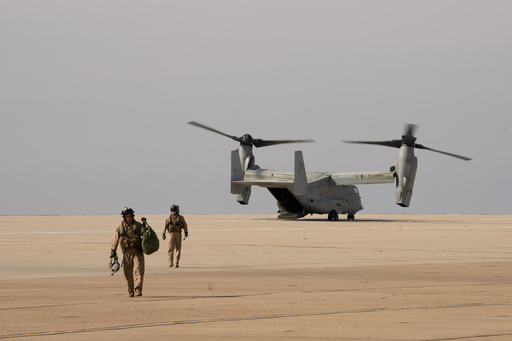SAN DIEGO — Over the weekend, numerous Marines were observed unrolling coils of concertina wire both on the ground and at a height above, significantly complicating any attempts to scale the border wall that divides Tijuana from San Diego. They executed their task with notable speed and efficiency, even as traffic surged nearby at one of the most active border crossings between the United States and Mexico.
The reinforcement of barriers has historically been a military function during border operations, a practice that can be traced back to the presidency of George W. Bush. However, former President Donald Trump suggested a bold and unprecedented approach involving the military to counter what he described as a “disastrous invasion.”
Up until this point, the military’s role has been primarily supportive, focusing on surveillance for undocumented crossings by land and air, maintaining equipment, and constructing barriers, all while complying with the Posse Comitatus Act enacted in 1878, which restricts military involvement in civilian law enforcement.
A recent tour of the San Diego area with the Marines revealed military operations reminiscent of those from previous missions. Nevertheless, certain scholars and advisors close to Trump argue that legal precedence exists to empower the military to address issues surrounding drug trafficking and mass migration.
Trump’s declaration of a national emergency at the southern border implies a potential reevaluation of funding streams, as he has done in the past, to secure billions for border wall development. His initial directives raise the potential for invoking wartime authority, specifically the Insurrection Act of 1807, which could enable the deployment of active-duty troops to quell any form of insurrection. He has tasked Defense Secretary Pete Hegseth and Homeland Security Secretary Kristi Noem with delivering actionable recommendations within 90 days.
According to Adam Isacson, who studies military involvement at the Washington Office on Latin America, the Insurrection Act provides expansive powers, “The regular military can do anything on U.S. soil.”
Trump’s approach diverges from that of prior administrations. Although the military has occasionally housed migrants, the deportation flights to Guatemala, Ecuador, and Colombia signal a fundamental shift in policy. Trump proposed utilizing a detention facility at Guantanamo Bay, Cuba, to detain thousands of the “worst criminal aliens,” a notion that remains unrealized.
Many Border Patrol agents and observers sense that this could be the beginning of more extensive changes. Isacson speculates that the current administration may be inspired by Texas Governor Greg Abbott’s “Operation Lone Star,” which has been pivotal in involving the state’s National Guard in border security.
In Trump’s inaugural week, the Department of Defense dispatched 1,600 active-duty personnel to the border. U.S. officials indicated preparations for the deployment of at least an additional 1,000 troops as part of the intensified immigration enforcement measures, split between the border and Guantanamo Bay.
Up to now, the military presence in San Diego has been considerably low-key. Marines placed concertina wire at the base of an 18-foot-high border wall, which already featured wire on its upper side. Migrants who manage to overcome or bypass the wire confront a second wall that rises to a staggering 30 feet.
A flight on Osprey military transport aircraft was utilized to transport concertina to Brown Field Municipal Airport in San Diego. Observations revealed Border Patrol vehicles strategically positioned at various lookout points, extending for approximately 70 miles from the Pacific coastline through rocky ranchlands east of San Diego and across challenging mountain terrain where few migrants venture.
Border Patrol Chief Michael Banks reported that illegal crossing arrests averaged 654 per day over the preceding week, a decrease from a daily mean of 1,527 in December. San Diego has maintained its status as the most frequented route for illegal crossings throughout much of the previous year, with the daily average of arrests dropping to 222 over a week ending January 25, down from 237 the previous week.
